∞ generated and posted on 2016.08.26 ∞
Membrane-enclosed, basic, replicable unit of living things.
Cells consist of a plasma membrane dividing the cytoplasm from material found exterior to the cell along with various organelles (sub-cellular machines) that are found within the cytoplasm. The cells of fungi, plants, algae, and bacteria also possess cell walls to the exterior of the plasma membrane.
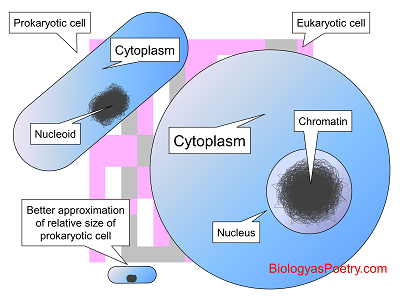
Figure legend: A eukaryotic cell (lower-right) and bacterial cell (upper-left), both with cytoplasms indicated (cells are not drawn to scale, i.e., eukaryotic cells generally are much larger than bacterial cells). Note that the cytoplasm is the fluid volume that is found between the nucleus and the cell membrane. In prokaryotic cells, which by definition lack a cell nucleus, the cytoplasm is the fluid volume that is contained with the plasma membrane. Note, though, that while membrane-bound organelles are found within the cytoplasm, their interiors are considered to be neither continuous with nor a part of the cytoplasm. Thus, a cell can be thought of in terms of three compartments, plus a fourth category of compartments: extracellular volumes (these are found external to the plasma membrane), the plasma membrane itself, the cytoplasm, and, lastly, the lumens of membrane-bound organelles such as mitochondria along with members of the endomembrane system.
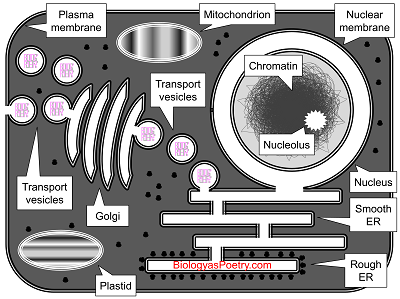
Figure legend: The very basics of eukaryotic cell anatomy. The double line surrounding most the organelles represents either endomembrane or, in the case of the exterior of the cell, the plasma membrane. The mitochondrion and plastid (which includes chloroplasts) are both shown surrounded by triple lines to indicate their double membranes. The nucleus too possess a double membrane, one that is continuous with the interior (lumen) of other endomembrane system members, particularly the endoplasmic reticulum. This lumen is shown as white to indicate its equivalent orientation to that of extracellular environment, that is, as found outside of the plasma membrane. Ribosomes are the black dots found throughout the cytosol (dark gray as found bounded by the plasma membrane) and in association with the rough endoplasmic reticulum (rough ER). Note that additional components associated with numerous eukaryotic cell types are not shown, such as cytoskeleton, cell walls, and flagella or cilia.
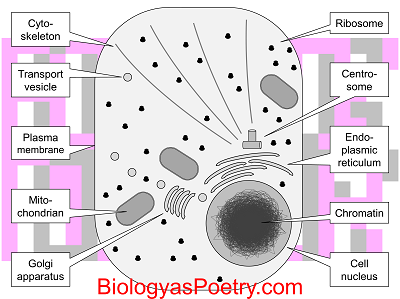
Figure legend: An animal cell with various organelles featured but not including a flagellum or cilia, which are found on some but not all animal cells. In comparison with plant cells, note the absence of a cell wall and chloroplasts as well as the presence of a centrosome and cytoskeleton (the latter here depicted as microtubules). Centrosomes will be considered especially in the following chapter in terms of their role in mitosis though here note their central place within the microtubule-based cytoskeleton (with only a fraction of the latter depicted in the figure).
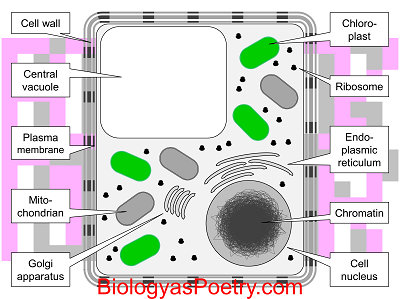
Figure legend: Schematic of a plant cell. Note the central vacuole shown at the top-left. Note also that while one typically thinks of plants as both stationary organisms and ones possessing cell walls, in fact primitive plants possess flagellated sperm which serve the same function as sperm in animals. That is, the movement toward egg cells to achieve fertilization. Note that transport vesicles as well as secretory vesicles are present in plant cells but have been depicted in this figure.
Cells are either capable of duplicating themselves or descendants of such replication-competent entities. In addition, for all cells the hereditary material consists of DNA.
Radio (Starts out a little slow but really does a good job of giving a sense of what cells are all about as well as where they came from, particularly eukaryotic cells)
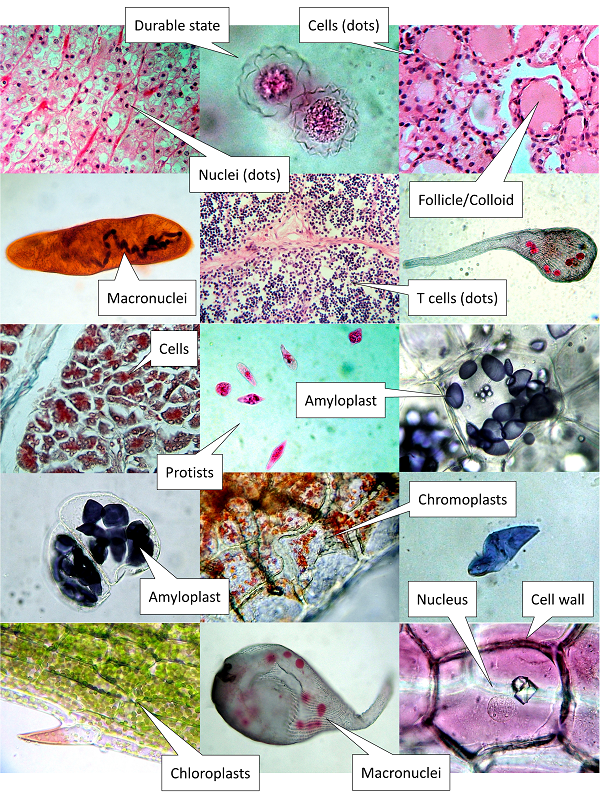
Figure legend: Left to right by row: Human adrenal gland, Volvox zygotes (a kind of algae), thyroid gland, Spirostomum (a kind of protist), fetal thymus, stentor (a kind of protist), human pancreas cells, Euglena (a kind of protist), Elodea (a kind of protist), potato wet mount (iodine stained), banana cell wet mount (iodine stained), red pepper skin wet mount, human cheek cell wet mount, Elodea wet mount (a kind of plant), stentor (a kind of plant), purple onion wet mount (stained with iodine).